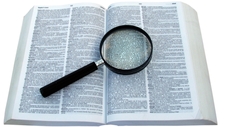Hand Lenses

TEKS Objective
The student is expected to collect data and make observations using simple equipment such as hand lenses, primary balances, and non-standard measurement tools.
Essential Understanding
The student develops abilities to ask questions and seek answers in classroom and outdoor investigations.
Science Background
Magnifying Glass Facts and FAQs: See It Bigger (website) - General information about magnifiers, including an explanation of focal length, the role of lens size, types of lenses, etc.
Magnifying Glass Facts and FAQs
See It Bigger, www.seeitbigger.com
Signature Lesson
Magnify It! Science Netlinks (website) - Magnifying glasses can help extend the limits of our eyes by making objects appear larger. In this activity, students observe objects at different distances to learn that magnifying glasses allow them to see in greater detail at close distances.
- Supporting Lessons
- Extensions
- Assessment Ideas
- Literature Connections
- Related
TEKS - Additional Resources
Supporting Lessons
Magnify That: Elementary Globe (PDF) - Students lean about magnification by making and using pinhole magnifiers, and by using hand lenses to observe grains of salt and sugar.
Elaboration Lessons and Extensions
Nature Spies: Houghton Mifflin Education Place (website) - Lead students on a nature walk to a local park or the school playground. Observe trees, flowers, plants and insects. Have students use a hand lens for close views, and then record their observations in their science notebooks.
Nature Spies
Houghton Mifflin Education Place, www.eduplace.com
Assessment Ideas
Give each student a hand lens and a leaf or mealworm. Have students observe their object using the hand lens, make a detailed drawing of what they see, and make a list of words describing the object.
Literature Connections
You Can Use a Magnifying Glass. Blevins, Wiley (ISBN-13: 978- 0516273280)
Experiments with a Hand Lens. Tocci, Salvatore (ISBN-13: 978- 0516269948)
Adventures with a Hand Lens. Headstrom, Richard (ISBN-13: 978-0486233307)
Additional Resources
Looking Through Lenses: Science Optics and You (website) - Fun activities that enable students to explore the properties of convex and concave lenses.
Looking Through Lenses
Science Optics and You, micro.magnet.fsu.edu
TEKS Navigation
Grade 1
Need Assistance?
If you need help or have a question please use the links below to help resolve your problem.

Comments